|
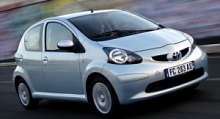 Toyota
is the most versatile car maker in the world. Its vehicle lineup covers
more market segments than any other car makers. But except the
A-segment. This is the lowest price segment in Europe. At the moment it
is dominated by Fiat and the Korean. Although Toyota is renowned for
production efficiency, it is still impossible to match the low cost of
these rivals. That's why it decided to build a factory in the Czech
Republic to produce a new small car targeted the A-segment. Toyota
is the most versatile car maker in the world. Its vehicle lineup covers
more market segments than any other car makers. But except the
A-segment. This is the lowest price segment in Europe. At the moment it
is dominated by Fiat and the Korean. Although Toyota is renowned for
production efficiency, it is still impossible to match the low cost of
these rivals. That's why it decided to build a factory in the Czech
Republic to produce a new small car targeted the A-segment.
But doing it alone does not make business sense, because by calculation
the Toyota brand could only attract 100,000 sales of this car every
year. At this production scale, the cost of building and running a
plant and the purchasing price of parts from local suppliers would be
too high to make money. That's why 3 years ago Toyota signed an
agreement with PSA group to set up a joint-venture. They co-own the
Czech factory and produce the car in 3 versions – Toyota Aygo, Citroen
C1 and Peugeot 107. Each car is expected to take 100,000 units of sales
annually, thus 300,000 units in total. That would be enough to make a
profit.
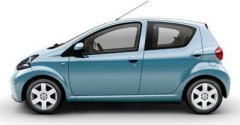 Basically,
the three cars are the same except the clothes – some 92% of parts are
common. As it was conceived and engineered by Toyota, PSA's involvement
was rather limited - it styled its own cars, it provides a diesel
engine, it negotiated with landlords and talked with local suppliers.
That's why we had better to concentrate on Toyota Aygo. Basically,
the three cars are the same except the clothes – some 92% of parts are
common. As it was conceived and engineered by Toyota, PSA's involvement
was rather limited - it styled its own cars, it provides a diesel
engine, it negotiated with landlords and talked with local suppliers.
That's why we had better to concentrate on Toyota Aygo.
The Aygo pronounces “I go”. This implies its target buyers are young
people who are about to have their first taste of car ownership. To
attract young buyers, it adopts a funky styling. Imitating Smart, it
has front and rear wheelarches extended beyond the body in north-south
direction, creating a sporty, “I want to go” feel. What a pity Toyota
still failed to establish a beautiful corporate grille, despite of
countless of attempts. This means the Aygo looks somewhat strange when
viewing from the front.
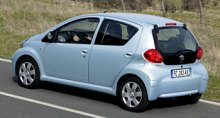 The Aygo has a compact
bodyshell. It measures 3.4 meters in length, slightly shorter than Fiat
Panda and Kia Picanto. Its 2.34 meter wheelbase slots between Panda
(2.30m) and Picanto (2.37m). At 1465 mm tall, it is rather low by
today's standard, especially compare with the 1540mm Fiat. Inside, you
will find a spacious cabin for the front passengers, but the rear is no
match with Picanto. Compare with Panda, there is more rear legroom but
less headroom. The combination of lower roof and thick C-pillars does
not promote a light and airy feel you found in its rivals. The Aygo has a compact
bodyshell. It measures 3.4 meters in length, slightly shorter than Fiat
Panda and Kia Picanto. Its 2.34 meter wheelbase slots between Panda
(2.30m) and Picanto (2.37m). At 1465 mm tall, it is rather low by
today's standard, especially compare with the 1540mm Fiat. Inside, you
will find a spacious cabin for the front passengers, but the rear is no
match with Picanto. Compare with Panda, there is more rear legroom but
less headroom. The combination of lower roof and thick C-pillars does
not promote a light and airy feel you found in its rivals.
Compare with Japanese K-cars, the deficit in space efficiency is even
more. Take Daihatsu Mira (Charade) for example, it measures the same
length as Aygo, but its wheelbase is a full 50 mm longer ! No wonder
the Daihatsu can swallow a family while the Toyota is primarily a
personal car with additional ability to carry adults for short journey.
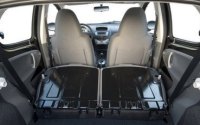 Luggage carrying capability is
another weakness of Aygo. Its boot capacity is a dismal 139 litres. Its
50-50 split rear seat can neither slide nor fold flat. It does not
offer the flexibility required by today's youngsters. Luggage carrying capability is
another weakness of Aygo. Its boot capacity is a dismal 139 litres. Its
50-50 split rear seat can neither slide nor fold flat. It does not
offer the flexibility required by today's youngsters.
However, no one can deny Aygo is a safe and high-quality small car.
From the moment you shut the door, you will see it sets new quality
standard for the A-segment. The solidity of its bodyshell and interior
construction, the tight panel gaps, the fine seats and the amazing
level of safety features (carefully-designed crumple zone, the use of
high strength steel, 8 air bags, seatbelt pretensioners and ISOFIX
system)... all have no right to appear on a mini car produced in
Eastern Europe. But thanks to Toyota, small car buyers no longer need
to tolerate the quality and reliability problems usually encountered in
Fiat and Korean products.
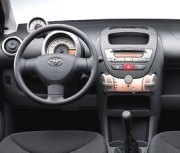 Engine is another strength of
the Japanese. The Aygo employs the 68 hp (DIN) 1.0-litre VVT-i 12V
three-cylinder engine recently launched in Toyota Passo and Daihatsu
Boon. This all-alloy engine not only has the best power in the
1.0-litre class but also the lightest weight (68 kg) and the lowest
fuel consumption (61.4 mpg) in the A-segment. It is willing to rev and
fairly refined for a 3-cylinder engine. Thanks to a special engine
mount, the 3-pot transmits little vibration into the cabin. Engine is another strength of
the Japanese. The Aygo employs the 68 hp (DIN) 1.0-litre VVT-i 12V
three-cylinder engine recently launched in Toyota Passo and Daihatsu
Boon. This all-alloy engine not only has the best power in the
1.0-litre class but also the lightest weight (68 kg) and the lowest
fuel consumption (61.4 mpg) in the A-segment. It is willing to rev and
fairly refined for a 3-cylinder engine. Thanks to a special engine
mount, the 3-pot transmits little vibration into the cabin.
The car weighs less than 800 kg, so the 1.0 litre engine is capable
enough for normal driving. The light steering and short turning circle
makes it at home in city. If you push the car into corner, you will
find too much body roll and too little feel from its electric power
steering, so Aygo is clearly not designed to be a hot hatch. But by
city car standard, it rides and handles competent enough.
The emergence of Aygo sends warning signals to Fiat. Although Panda is
still better overall, the baby Toyota hits right at the weakness of
Fiat – quality and reliability. Yaris was the first step of Toyota's
invasion into the European heartland. Now Aygo is the second step.
Sooner or later we will see the Japanese giant become a dominating
force there. |